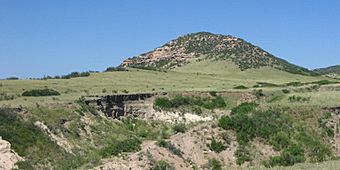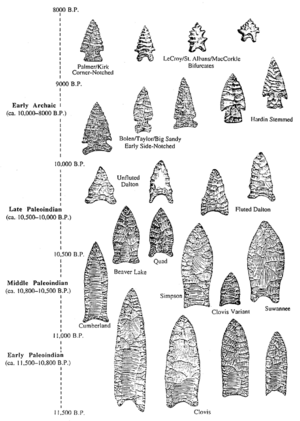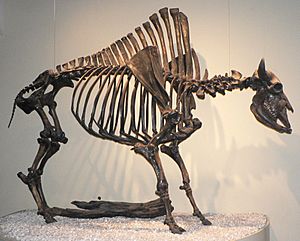Lindenmeier Site facts for kids
|
Lindenmeier Site
|
|

The arroyo surrounding the Lindenmeier site.
|
|
| Lua error in Module:Location_map at line 420: attempt to index field 'wikibase' (a nil value). | |
| Nearest city | Fort Collins, Colorado |
|---|---|
| NRHP reference No. | 66000249 |
Quick facts for kids Significant dates |
|
| Added to NRHP | October 15, 1966 |
| Designated NHL | January 20, 1961 |

The Lindenmeier Site is a very important archaeological site in northeastern Larimer County, Colorado, United States. It's famous for showing us how people lived during the Folsom tradition period. This means it's a place where archaeologists have found many clues about the Folsom culture, which existed thousands of years ago.
The site is located in the Soapstone Prairie Natural Area, near Fort Collins, Colorado. It's the biggest Folsom culture campsite ever found. Scientists have used radiocarbon dating to figure out that people lived here around 10,600 to 10,720 years ago. Later, people from other ancient periods also used this area.
Because it's so important, the Lindenmeier Site was named a National Historic Landmark in 1961. This means it's a special place that helps us understand American history.
Contents
Ancient History of the Lindenmeier Site
The Ice Age and Early Hunters
About 16,000 years ago, the Ice Age was ending. Over the next 5,000 years, the land changed a lot. Huge glaciers melted, forming rivers and shaping the mountains we see today. Many large animals, like mastodons, mammoths, giant sloths, and huge bison antiquus, roamed the land.
The first humans in Colorado were called Paleo-Indians. They used different kinds of tools depending on the animals they hunted. The earliest group, called the Clovis people, used large tools to hunt the biggest animals.
The Folsom People and Their Lives
As the climate got warmer, the land became drier. Many of the giant animals died out because there wasn't enough food. People had to change how they lived. They started hunting smaller animals and gathering wild plants like seeds and fruits. This led to a new culture called the Folsom tradition.
The Folsom people made smaller, special Folsom points for hunting. The Lindenmeier Site is the largest known Folsom campsite. It shows us how these ancient people lived about 11,000 years ago. They were nomadic, meaning they moved around a lot. They followed herds of Bison antiquus and set up camps in different places throughout the year.
Tools and Art from the Past
The tools and artifacts found at Lindenmeier tell us a lot about the Folsom people:
- They made many types of tools, like spearheads and scrapers. These tools were used for chopping, slicing, and preparing animal hides.
- They used pieces of hematite (a red mineral) to make red paint. Maybe they used it for their faces or for art!
- Archaeologists found small, round discs with designs and polished surfaces. These are some of the oldest pieces of Paleo-Indian art found in Colorado.
- Because so many different tools and items were found, scientists believe Lindenmeier was a main campsite where people lived, not just a hunting spot.
While bison were their main food, an ancient camel bone was also found. This bone might have been carried from another area, as it was the only one found.
Later Visitors to the Site
The Lindenmeier Site shows signs of people living there for over 13,000 years. Even though most of the finds are from the Folsom tradition, there are also artifacts from later periods.
For example, Yuma points were found, which are from a time a little after the Folsom period. Other tools from the Archaic and Late Prehistoric periods were also discovered. The smaller number of these later artifacts suggests that these groups might have stayed for shorter times or that there were fewer resources available.
What Archaeologists Found
Archaeologists have collected tens of thousands of stone and bone artifacts from the Lindenmeier Site. These items come from different time periods:
| Time Period | Years Ago | Cultures | How People Lived |
|---|---|---|---|
| Paleo-Indian | 11,500 to 8,000 years ago | Folsom, Late Paleo-Indians | Mainly hunted large animals. |
| Archaic | 8,000 to 2,200 years ago | Yuma, McKean | Hunted smaller animals like deer and rabbits. They also gathered wild plants. People moved with the seasons. Later, they started growing corn and making pottery. |
| Late Prehistoric | 2,200 years ago until Europeans arrived | People became more settled, sometimes living in one or two places. They grew crops, raised animals, made pottery and baskets, and had special ceremonies. |
Studying the Lindenmeier Site
Early Discoveries by the Coffin Family
The Lindenmeier Site was first explored in 1924 by the Coffin family. A. Lynn Coffin, his father Judge Claude C. Coffin, and possibly Ranger C. K. Collins found the site. Later, Major Roy G. Coffin also visited many times.
At first, they didn't know what the spear points they found were. But in 1926, Dr. E. B. Renaud from the University of Denver identified them as Folsom points, like those found at the Folsom Site in New Mexico. The Coffin family spent over 10 years finding many Folsom artifacts and bison bones. Their work sparked a lot of interest from scientists. In 1937, Roy Coffin wrote a book about their discoveries. The site is named after William Lindenmeier, Jr., who owned the land at the time.
Professional Research at the Site
Most of the professional archaeological work at Lindenmeier happened between 1934 and 1940.
- Frank H. H. Roberts from the Smithsonian Institution led many of these studies. They found huge bison bones, showing that the ancient bison were about 7 feet tall!
- In 1937, Dr. Kirk Bryan and Louis L. Ray figured out that the artifacts were from the Late Glacial period.
- John L. Cotter led a team from the Colorado Museum of Natural History (now the Denver Museum of Nature and Science) from 1935 to 1938. Most of the digging was finished by 1938.
- In 1960, C. Vance Haynes, Jr. and George Agogino used radiocarbon dating to find the age of the site. In 1992, they confirmed that people lived there about 10,600 to 10,720 years ago.
Where to See the Artifacts Today
As of 2002, many artifacts from the Lindenmeier Site are kept in different places:
- The Claude C. and A. Lynn Coffin collection, with over 1,100 artifacts, is mostly at the Smithsonian Institution.
- Major Roy G. Coffin's collection is at the Fort Collins Museum and Discovery Science Center.
- The Denver Museum of Nature and Science also has artifacts from the site.
Visiting the Soapstone Prairie Natural Area
The City of Fort Collins bought the Lindenmeier Site in 2004. It's now part of the Soapstone Prairie Natural Area, which opened to the public in 2009. You can visit the area and see the site from a special overlook. There are signs that explain its history and importance.


